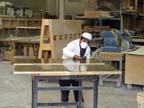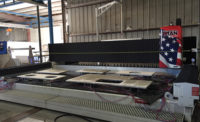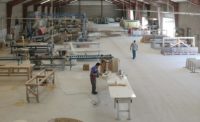

In the late '90s, Fernandez began to seriously research the granite business - its demand, applications, availability, characteristics, strengths, profitability, machinability and so on. The investigation piqued his interest and convinced him that expanding into granite was a good business decision. He began a search for a new, larger facility that would provide enough space to handle the existing Corian workload, plus new granite orders. Fernandez purchased a 2.5-acre parcel of land with 25,000 square feet of manufacturing and office space in the shadows of the Mandalay Bay Hotel and Casino.
Fernandez then began researching stone-processing machinery that would accurately and reliably cut granite to exact specifications and tight tolerances. Rather than using hand tools and manual machines, he reasoned that sophisticated, automated equipment would give him a competitive advantage. He gathered information from several major stone machinery builders, visited Web sites, traveled to see various machines in operation and talked directly to as many stone machinery salesmen and senior executives as he could. He wanted to select one manufacturer that could provide all the different machinery, training and service.
After much study and consideration, Fernandez's first purchase was an HTO-1B bridge saw from Marmo Meccanica USA. “I purchased it for several reasons,†he explained. “A bridge saw is the workhorse of any granite shop, and Marmo Meccanica USA equipment has an excellent reputation. I liked their bridge saws and polishers for both strength and appearance. Their machines are well built and can handle continuous operation for two shifts, day-after-day, like we have here.
“In addition, I had a good rapport with the Marmo Meccanica USA salespeople and management. I saw this as a long-term relationship. They understood my situation and needs and were helpful in the proper selection of equipment. Plus, the cost of equipment was right. They were neither the most expensive, nor the least expensive. And finally, they have sales, service and repair parts availability - a one stop shop - which was an important consideration for me.â€
The HTO-1B bridge saw was purchased primarily to cut granite countertops to specific lengths. The saw's cutting speed of 120 lineal feet of 3-cm material per hour was an attraction for the company. Another desirable feature was the saw's simple programmable controls, according to Cristo Fernandez, Esteban's son, who manages granite machining operations. He learned through Marmo Meccanica's training program that he can program its movement in manual, semi-automatic and automatic cutting modes. In all, it can program up to 792 different cuts for maximum flexibility over a wide range of jobs.
Additional flexibility was provided because the unit's cutting blade head tilts from 0 to 90 degrees, allowing the company to meet a broad range of cutting needs as dictated by the customer. Furthermore, the saw has an hydraulic tilting table that has proven to be a great asset in loading slabs on the cutting surface, Fernandez reports, adding that it has reduced manpower requirements as well as potential injuries to shop personnel.
With the positive experience of the bridge saw purchase, Fernandez acquired a water recycling system to save water through Marmo Meccanica USA. Although these are becoming more common throughout North America, Fernandez said they are virtually a necessity in the arid climate of Las Vegas. The automated system treats the wastewater that results from cutting granite slabs. It separates water from sludge, purifies the water for reuse and dehydrates the sludge, facilitating its disposal. By re-using process water, water consumption and associated costs are substantially reduced.
Fernandez's next purchase was a Marmo Meccanica USA LBF-1, a single-head polishing machine for round and flat edges from 1 to 10 cm thick. Its single moving spindle inclines from 0 to 180 degrees for 100- to 130-mm diameter wheels, providing the company with the ability to process a wide variety of processed edge applications. Cristo Fernandez said the aggressive character of diamond discs allows the material to move through the machine at a faster rate than with bricks, and he added that its small footprint is another plus.
As stone orders continued to increase, another flat edge polishing machine was purchased. This time it was a Marmo Meccanica LCV 711M, a small footprint machine with seven heads used primarily for flat edges on backsplashes. This machine was selected because it works continuously; all the pieces are loaded one after the other on the machine and move past a series of mandrels so that they come out completely finished.
Another advantage of this machine is the orientation of the granite, according to Fernandez. Granite pieces are inserted vertically, as they are normally handled. This system minimizes the possibility of breaking the material as well as reducing clutter in the machine and the workspace. Because all polishing operations are completed at one time, the machine's production speed of 100 lineal feet per hour minimizes processing time.
Finally, a Marmo Meccanica LTH 721 inline polishing machine was purchased. Fernandez uses it for rounded-profile edges, flat or inclined edges and profiles combining flat and round shapes. The two cup-shaped, diamond grinding wheels are used for all curved areas. Like the LCV, pieces are loaded into the machine one after another, traversing through the series of mandrels until they are fully polished.
The different edging machines allow Fernandez to produce a variety of edges. Bullnose is the most common edge selected by customers, but other popular options include waterfall, bevel and flat.
“I like buying equipment from the same manufacturer,†said Fernandez. “That way, it's a one-stop shop for machines, service, training and spare parts. [Marmo Meccanica USA's] service department is wonderful. You couldn't ask for a better group of people for training and support.â€
Overall, Fernandez estimates that the machinery offers a one- to two-year return on investment. In addition to the machinery, Fernandez invested heavily in inventory and manufacturing space. Today, the company stocks hundreds of slabs of granite, made up of about 40 different color types.
Although Fernandez has been successful in granite since expanding into it four years ago, he's not satisfied. He's planning on expanding the building another 5,000 square feet and purchasing more granite processing equipment. “I'd like to double the amount of equipment I have now,†he said. “It's important for me to have all the capital equipment I need to handle all the granite countertops orders that I bid on. As it is now, I have to turn down jobs because of an existing huge Corian and stone backlog. I'll only take work for which I know I can deliver the best quality and service.â€
Fernandez hopes to increase the $2 million in granite countertop sales in 2004 by about 20% in 2005.

